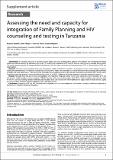| dc.contributor.author | Awadhi, Bayaoum | |
| dc.contributor.author | Mboya, Beati | |
| dc.contributor.author | Temu, Florence | |
| dc.contributor.author | Ngware, Zubeda | |
| dc.date.accessioned | 2021-08-16T21:49:16Z | |
| dc.date.available | 2021-08-16T21:49:16Z | |
| dc.date.issued | 12/25/2012 | |
| dc.identifier.citation | Bayoum Awadhi, Beati Mboya, Florence Temu, Zubeda Ngware. Assessing the need and capacity for integration of Family Planning and HIV counseling and testing in Tanzania. Pan Afr Med J. 2012;13(Supp 1):6 | en_US |
| dc.identifier.issn | N 1937-8688 | |
| dc.identifier.uri | http://dspace.amref.org/handle/123456789/57 | |
| dc.description | This article is published as part of the supplement “AMREF´s evidence in advancing the health of women and children”
Supplement sponsored by AMREF - African Medical and Research Foundation
© Bayoum Awadhi et al. The Pan African Medical Journal - ISSN 1937-8688. This is an Open Access article distributed under the terms of the Creative Commons Attribution License (http://creativecommons.org/licenses/by/2.0), which permits unrestricted use, distribution, and reproduction in any medium, provided the original work
is properly cited. | en_US |
| dc.description.abstract | Introducton: In Tanzania, only 27% of currently married women are using modern Family Planning (FP) methods. HIV counseling and testing
outlets are potential avenues for addressing the unmet FP needs through integration of FP and HIV services, reaching out to sexually active people.
This study assessed capacity for integrating family planning into HIV voluntary counseling and testing services (HTC) in Dar-es-Salaam (DSM) and
Coast regions.
Methods: This was a mixed methods study using triangulation model conducted in two districts to represent rural and urban settings. Questionnaires were administered to 147 randomly selected service users and 35 health providers while 10 in-depth interviews were conducted among Ministry
of Health and Local government. Four focus group discussions were conducted among HIV voluntary counselling and testing (VCT) service users.
Quantitative data was analyzed using descriptive statistics with aid of SPSS. Qualitative data were analyzed by thematic framework approach.
Results: Although there was gap in policy and guidelines with regards to integration, policy makers were willing to pioneer integration of FP and
HIV services. Health providers support provision of FP/VCT services by the same health provider. Only 25% of health providers were trained on both
FP and HTC services. Existing national monitoring and evaluation tools can be used with little modification to capture data for both services. Eighty
five percent (85%) of clients indicated satisfaction with integrated services.
Conclusion: Integration of FP and HTC is feasible and acceptable with minor re-arrangement. Involvement of multiple stakeholders especially at
district level is critical in enhancing integration. | en_US |
| dc.description.sponsorship | The government of Tanzania/MoHSW | en_US |
| dc.language.iso | en | en_US |
| dc.publisher | Pan African Medical Journal | en_US |
| dc.subject | HIV Counseling and testing | |
| dc.subject | Integration | |
| dc.subject | Service | |
| dc.subject | Family planning | en_US |
| dc.title | Assessing the Need and Capacity for Integration of Family Planning and HIV Counseling and Testing in Tanzania | en_US |
| dc.type | Article, Journal | en_US |

